6월 15, 2018 / 경상대학교, 대한민국 / Journal of Clinical Medicine
글/ 우팅야오
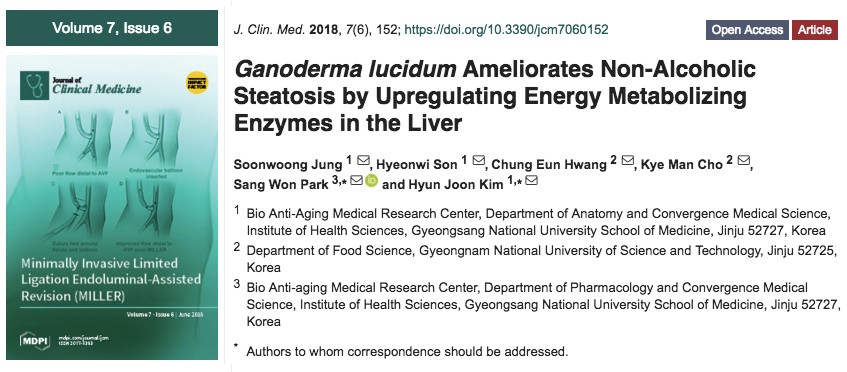
Gyeongsang National University School of Medicine in South Korea published a paper in the Journal of Clinical Medicine in June 2018 stating that영지버섯 can reduce liver fat accumulation caused by a high-fat diet, but related animal experiments also found that that mice fattened by a high-fat diet will also have less serious blood glucose and blood lipid problems due to the intervention of영지버섯.
The experimental mice were divided into four groups: normal diet (ND), normal diet (ND) + 영지버섯 (GL), 고지방식이 (HFD), 고지방식이 (HFD) + 영지버섯 (GL). In the feed of the normal diet group, fat accounted for 6% of the total calories; in the feed of the high-fat diet, fat accounted for 45% of the total calories, which was 7.5 times of the former. 그만큼영지버섯 생쥐에게 먹인 것은 실제로는 자실체의 에탄올 추출물입니다.영지버섯. 연구진은 생쥐에게 다음과 같은 양을 먹였습니다. 50 mg/kg영지버섯 주 5일 동안 매일 에탄올 추출물.
16주 후 (4개월) 실험의, 장기간 고지방식을 하면 쥐의 체중이 두 배로 늘어날 수 있다는 사실이 밝혀졌습니다.. 먹더라도영지버섯, 체중 증가 경향을 차단하기가 어렵습니다. (수치 1).
하지만, 고지방식을 전제로, 비록 먹는 쥐들은영지버섯 그리고 안먹는 쥐들영지버섯 비슷한 수준의 비만이 있는 것 같습니다., 먹느냐 안 먹느냐에 따라 건강 상태가 크게 달라질 수 있습니다.영지버섯.
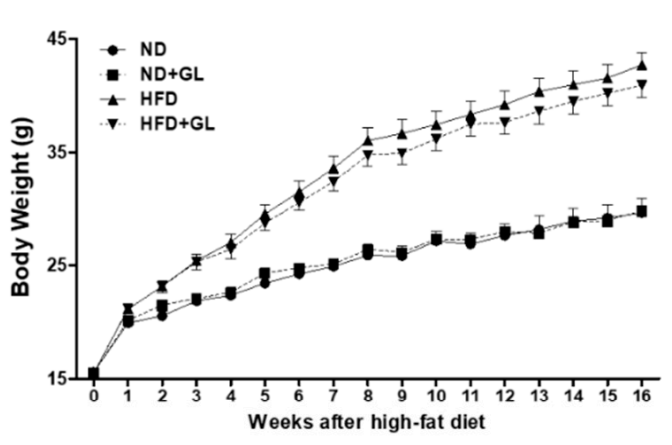
그림 1 효과영지버섯 HFD를 먹인 쥐의 체중에
영지버섯 HFD를 먹인 쥐의 내장 지방 축적을 감소시킵니다.
수치 2 간의 모양과 무게에 대한 통계도 입니다, 실험 종료 시 각 쥐 그룹의 신주위 지방과 부고환 지방.
간은 체내의 영양분을 처리하는 공장이다.. 장에서 흡수된 모든 영양소는 분해됩니다., 간에서 세포가 사용할 수 있는 형태로 합성되고 처리됩니다., 그런 다음 혈액 순환을 통해 모든 곳에 분포됩니다.. 일단 공급 과잉이 되면, 간은 과잉 칼로리를 지방으로 전환합니다 (트리글리세리드) 그리고 비상용으로 보관해두세요.
지방이 많이 쌓일수록, 간이 커지고 무거워집니다.. 물론, 과도한 지방은 다른 내부 장기에도 축적됩니다., 그리고 신주위 지방과 부고환 지방은 동물 실험에서 관찰되는 내장 지방 축적의 대표자입니다..
그림을 보면 알 수 있다 2 저것영지버섯 can significantly reduce fat accumulation in the liver and other internal organs caused by a high-fat diet.
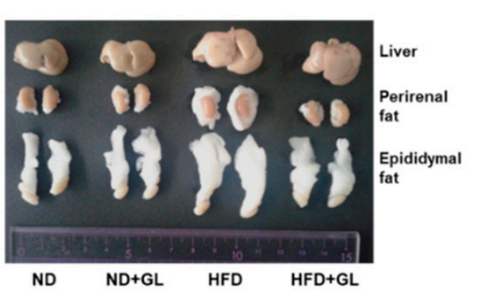
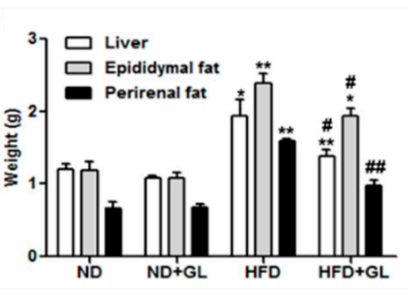
Figure 2 효과영지버섯 on visceral fat in HFD-Fed mice
영지버섯 reduces fatty liver in HFD-Fed mice.
The researchers further analyzed the fat content in the liver of the mice: the liver tissue sections of the mice in each group were stained with a special dye, and the oil droplets in the liver tissue would combine with the dye and turn red. As shown in Figure 3, the fat content in the liver was significantly different in the same high-fat diet with or without the addition of영지버섯.
The fat in liver tissues of mice in each group was quantified into Figure 4, and it could be seen that fatty liver in the high-fat diet group reached grade 3 (the fat content was more than 66% of the weight of the whole liver, indicating severe fatty liver). 동시에, the fat content in the liver of HFD-fed mice that ate영지버섯 was reduced by half.
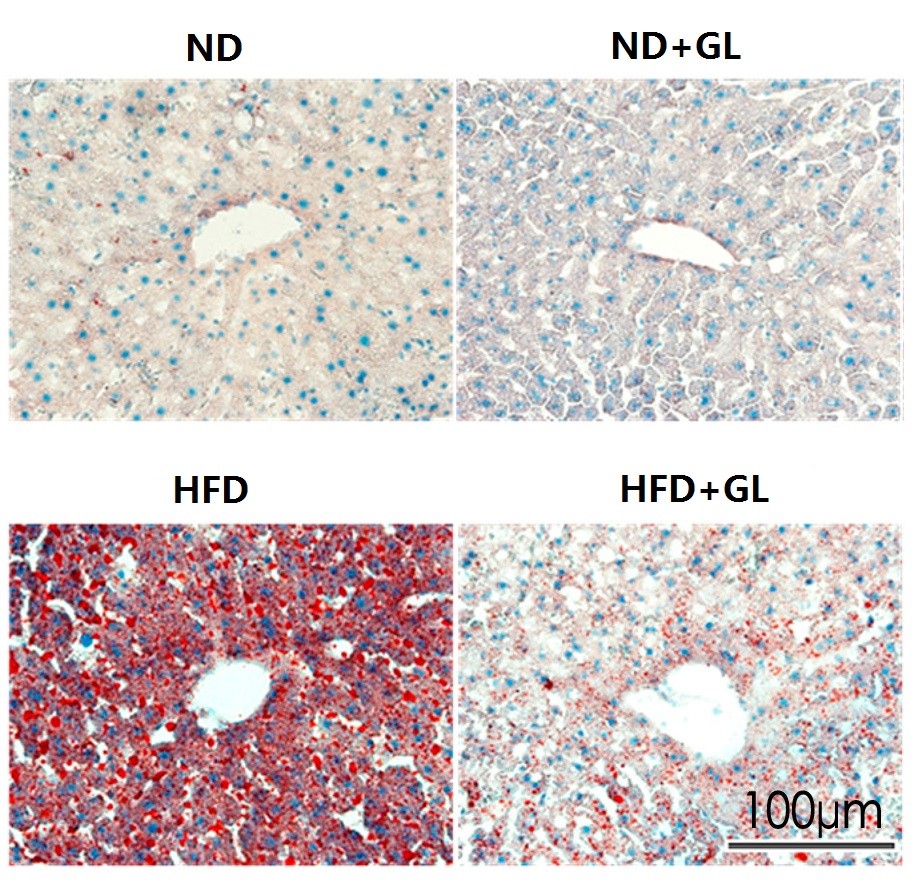
Figure 3 Fat staining results of mouse liver tissue sections
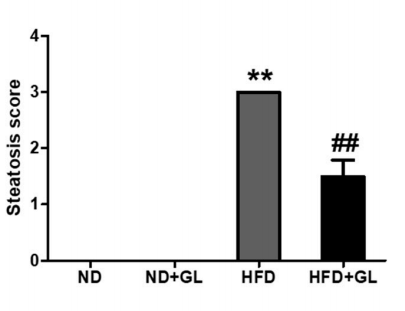
Figure 4 효과영지버섯 on liver fat accumulation in HFD-fed mice
[설명] The severity of fatty liver was classified into grades 0, 1, 2, 그리고 3 according to the proportion of fat weight in the liver weight: less than 5%, 5-33%, 이상 33%-66% 그리고 그 이상 66%, 각기. The clinical significance represented normal, mild, moderate and severe fatty liver.
영지버섯 prevents hepatitis in HFD-fed mice.
Excessive fat accumulation will increase free radicals in the liver, making liver cells prone to inflammation due to oxidative damage, thereby affecting liver function. 하지만, not all fatty livers will progress to the level of hepatitis. As long as the liver cells are not excessively damaged, they can be maintained in a relatively harmless “simple fat accumulation.”
그림을 보면 알 수 있다 5 that a high-fat diet can double serum ALT (GPT), the most important indicator of hepatitis, from the normal level of about 40 U/L; 하지만, 만약에영지버섯 is taken at the same time, the possibility of hepatitis is greatly reduced. 확실히, 영지버섯 has a protective effect on liver cells infiltrated in fat.
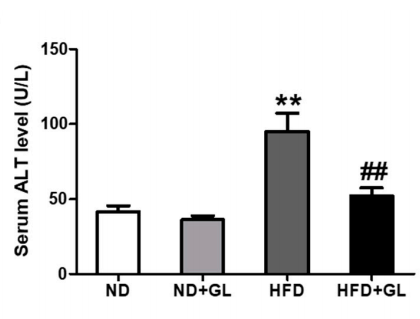
Figure 5 The effect of영지버섯 on hepatitis indexes in HFD-fed mice
영지버섯 relieves blood lipid problems in HFD-fed mice.
When the liver synthesizes too much fat, blood lipids are also prone to abnormalities. This animal experiment in South Korea found that a four-month high-fat diet can raise cholesterol, 하지만영지버섯 can reduce the severity of the problem (수치 6).
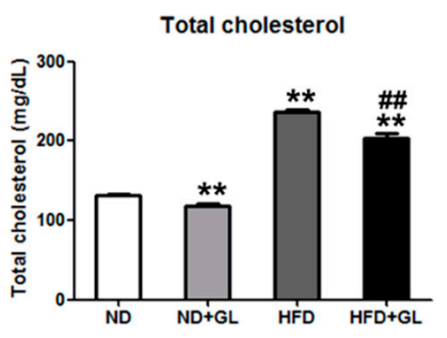
Figure 6 효과영지버섯 on serum total cholesterol in HFD-fed mice
영지버섯 inhibits blood glucose rise in HFD-fed mice.
Experiments also found that a high-fat diet can cause blood glucose to rise. 하지만, 만약에영지버섯 is taken at the same time, the blood glucose level can obviously be controlled at a small increase (수치 7).
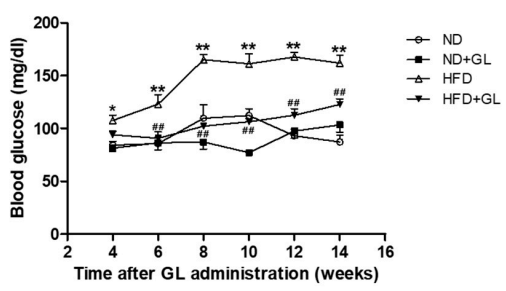
Figure 7 효과영지버섯 on blood glucose in HFD-fed mice
영지버섯 improves the ability of the body of HFD-fed mice to regulate blood sugar.
The researchers also performed a glucose tolerance test on the mice during the fourteenth week of the experiment, 즉, in the fasting state after 16 hours of fasting, the mice were injected with a high amount of glucose, and the blood glucose change within two hours was observed. The smaller the fluctuation of blood glucose level, the better the ability of the mouse’s body to regulate blood glucose.
It was found that the fluctuation of the blood glucose levels of the HFD + GL group was lower than that of the HFD group (수치 8). 이는 다음을 의미합니다.영지버섯 고지방식으로 인한 혈당 조절을 개선하는 효과가 있습니다..
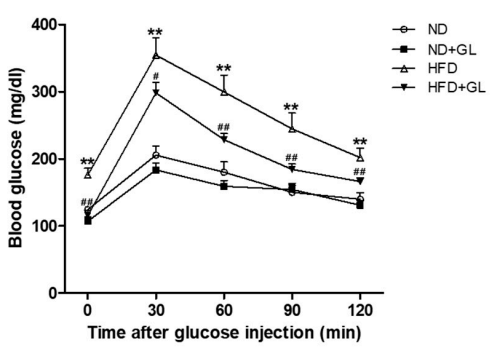
그림 8 효과영지버섯HFD를 먹인 쥐의 포도당 내성에 관한
영지버섯 HFD를 먹인 쥐의 인슐린 저항성을 향상시킵니다..
연구진은 또한 쥐를 대상으로 인슐린 내성 테스트를 수행했습니다.: 실험 14주차에, 단식한 쥐에게 인슐린을 주사했습니다., 혈당 수치의 변화는 쥐 세포의 인슐린 민감도를 결정하는 데 사용되었습니다..
인슐린은 호르몬이다, 열쇠 역할을 하는 것이, 음식에 포함된 포도당이 혈류에서 신체 세포로 들어가 에너지를 생성하도록 허용. 정상적인 상황에서는, 인슐린 주사 후, 원래 혈당 수치가 어느 정도 떨어지게 됩니다.. 인슐린의 도움으로 더 많은 혈당이 세포에 들어가게 되기 때문입니다., the blood sugar level will naturally decrease.
하지만, the results of the experiment found that a long-term high-fat diet would make cells become insensitive to insulin so the blood glucose level remained high after insulin injection, but at the same time, the blood glucose fluctuation in HFD-fed mice that ate영지버섯 was similar to that in ND-fed mice (수치 9). It is obvious that영지버섯 has the effect of improving insulin resistance.
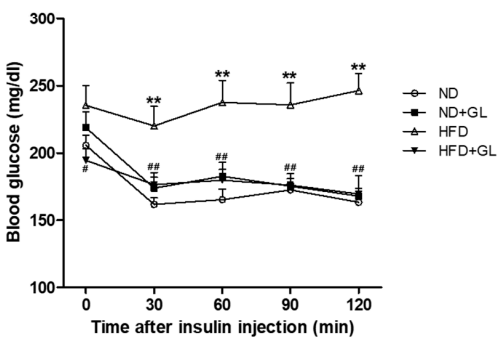
Figure 9 효과영지버섯 on insulin resistance in HFD-fed mice
메커니즘영지버섯 in reducing fatty liver
Obesity can induce insulin resistance, and insulin resistance not only causes hyperglycemia but also is the most important factor leading to non-alcoholic fatty liver. 그러므로, when insulin resistance is reduced by영지버섯, the liver is naturally less prone to fat accumulation.
게다가, the researchers also confirmed that the ethanol extract of영지버섯 동물 실험에 사용되는 자실체는 간에서 지질 대사에 관여하는 일부 효소의 활성을 직접적으로 조절할 수 있을 뿐만 아니라 간 세포의 지방 합성을 직접적으로 억제할 수도 있습니다., 그리고 그 효과는 복용량에 비례합니다.영지버섯. 더 중요한 것은, 이 유효량을 투여한 후영지버섯 인간의 간세포와 함께 배양되었습니다. 24 시간, 세포는 아직 살아 있었고 건강했습니다.
영지버섯 혈당을 낮추는 효과가 있습니다, 지방을 낮추고 간을 보호하는.
위에서 언급한 연구 결과는 알코올 추출물이영지버섯 자실체는 고혈당 증상을 줄일 수 있습니다, 고지혈증, 고지방식으로 인한 지방간뿐만 아니라 술을 마시지 않고도 지방간에 걸릴 수 있음을 상기시켜 줍니다..
의학에서, fatty liver caused by non-alcoholic factors is collectively referred to as “non-alcoholic fatty liver.” Although there are other possible factors (such as drugs), eating habits and lifestyle habits are still the most common causes. Think about how the foie gras, which is so much loved by gluttons, is made? It’s the same with people!
통계에 따르면, nearly one-third of adults have simple (즉, no symptoms of hepatitis) non-alcoholic fatty liver, and about one-quarter of them will further develop into fatty hepatitis within fifteen years. There are even reports that non-alcoholic fatty liver has become the main cause of abnormal ALT index in Taiwan (33.6%), far surpassing hepatitis B virus (28.5%) and hepatitis C virus (13.2%). (See reference 2 자세한 내용은)
Ironically, as global health agencies continue to fight viral hepatitis with vaccines and drugs, the prevalence of fatty liver disease caused by eating too well or drinking too much is increasing.
Fatty liver disease (steatosis) occurs when fat in the liver reaches or exceeds 5% of the liver’s weight. The initial diagnosis of fatty liver disease must rely on abdominal ultrasound or computed tomography (CT). If you have not developed the habit of undertaking health checkups, you can also judge whether you have fatty liver disease from whether you have metabolic syndromes such as moderate obesity, 고혈당증 (유형 2 당뇨병) and hyperlipidemia because these symptoms or diseases often occur together with nonalcoholic fatty liver disease (NAFLD).
It’s just that there are no specific drugs for fatty liver disease. This is why, after the diagnosis of fatty liver, the doctor can only prescribe you a light diet, exercise and weight loss rather than active treatments. 하지만, it is not easy to change eating habits and living habits. Most people are stuck either in the quagmire of “failing to control diet and increase physical activity” or in the struggle of “failing to get rid of fatty liver even by controlling diet and increasing physical activity”.
What on earth should we do? After reading the research results of Gyeongsang National University in South Korea, we know that there is another magic weapon, 즉, eating the ethanol extract of영지버섯 자실체.
영지버섯, which has the functions of protecting the liver, 혈당을 낮추는, and lowering fat, is really cost-effective; although it still cannot make you lose weight, it can at least make you healthier even if you are obese.
[원천]
Jung S, 외. 영지버섯 ameliorates non-alcoholic steatosis by upregulating energy metabolizing enzymes in the liver. J Clin Med. 2018 준 15;7(6). pii: E152. 도이: 10.3390/jcm7060152.
[Further Reading]
우연히, in early 2017, a report “Antidiabetic activity of영지버섯 polysaccharides F31 down-regulated hepatic glucose regulatory enzymes in diabetic mice” was jointly published by Guangdong Institute of Microbiology and Guangdong Provincial Center for Disease Control and Prevention. Based on an animal model of type 2 당뇨병, it explores the regulation mechanism of영지버섯 fruiting body active polysaccharides on blood glucose and the prevention and treatment of hepatitis caused by diabetes. Its mechanism of action is also related to the regulation of the enzymes involved in energy metabolism in the liver and the improvement of insulin resistance. It and this South Korean report arrive at the same end by different means. Interested friends might as well refer to this report.
Reference materials about non-alcoholic fatty liver
1. Teng-cing Huang et al. Nonalcoholic fatty liver. Family Medicine and Primary Medical Care, 2015; 30 (11): 314-319.
2. Ching-feng Suet al. Diagnosis and treatment of nonalcoholic fatty liver disease. 2015; 30 (11) : 255-260.
3. Ying-tao Wu et al. Introduction to the treatment of non-alcoholic fatty liver disease. Pharmaceutical Journal, 2018; 34 (2) : 27-32.
4. Huei-wun Liang: Fatty liver disease can be reversed and say goodbye to fatty liver! Liver Disease Prevention & Treatment Research Foundation website.
끝
저자 소개 / 씨. 우팅야오
Wu Tingyao는 이후 직접 Ganoderma 정보를 보고해 왔습니다. 1999. 그녀는 다음의 저자입니다. Ganoderma로 치유 (4월 인민의학출판사에 게재 2017).
★ 이 글은 저자의 단독 승인 하에 게재되었습니다..
★ 위 작품은 복제할 수 없습니다, 저작자의 허락 없이 발췌하거나 다른 방법으로 사용한 경우.
★ 위 사항을 위반한 경우, 저자는 관련 법적 책임을 추구할 것입니다.
★ 이 기사의 원문은 Wu Tingyao가 중국어로 작성하고 Alfred Liu가 영어로 번역했습니다.. 번역 내용에 차이가 있는 경우 (영어) 그리고 원본 (중국인), 원래 중국어가 우선합니다. 독자들이 궁금한 점이 있으면, 원작자에게 연락주세요, 양. 우팅야오.



